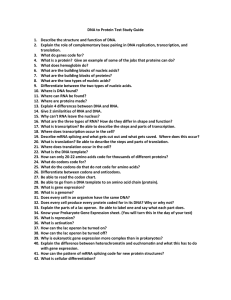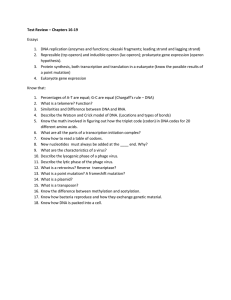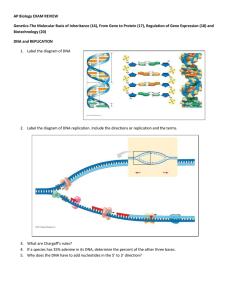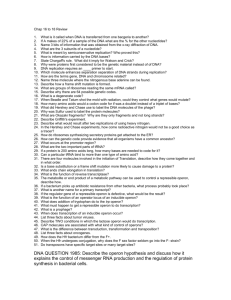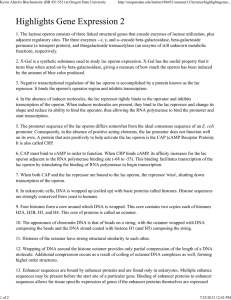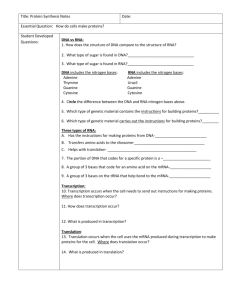Name: Biochemistry 465 Hour exam III
advertisement
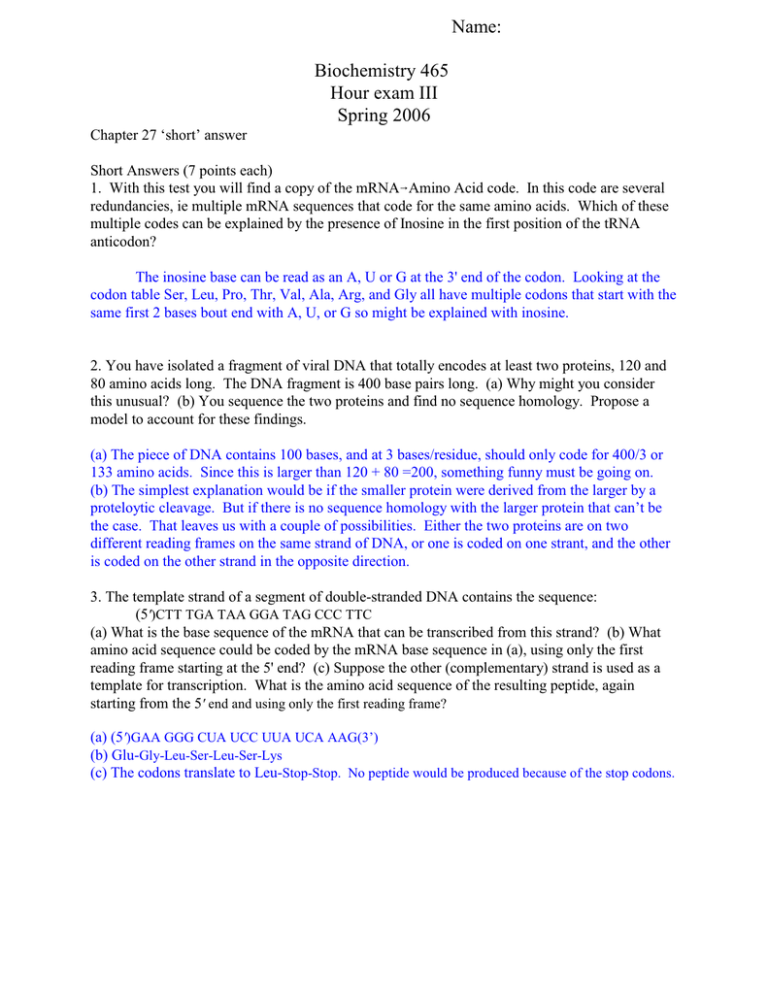
Name: Biochemistry 465 Hour exam III Spring 2006 Chapter 27 ‘short’ answer Short Answers (7 points each) 1. With this test you will find a copy of the mRNA6Amino Acid code. In this code are several redundancies, ie multiple mRNA sequences that code for the same amino acids. Which of these multiple codes can be explained by the presence of Inosine in the first position of the tRNA anticodon? The inosine base can be read as an A, U or G at the 3' end of the codon. Looking at the codon table Ser, Leu, Pro, Thr, Val, Ala, Arg, and Gly all have multiple codons that start with the same first 2 bases bout end with A, U, or G so might be explained with inosine. 2. You have isolated a fragment of viral DNA that totally encodes at least two proteins, 120 and 80 amino acids long. The DNA fragment is 400 base pairs long. (a) Why might you consider this unusual? (b) You sequence the two proteins and find no sequence homology. Propose a model to account for these findings. (a) The piece of DNA contains 100 bases, and at 3 bases/residue, should only code for 400/3 or 133 amino acids. Since this is larger than 120 + 80 =200, something funny must be going on. (b) The simplest explanation would be if the smaller protein were derived from the larger by a proteloytic cleavage. But if there is no sequence homology with the larger protein that can’t be the case. That leaves us with a couple of possibilities. Either the two proteins are on two different reading frames on the same strand of DNA, or one is coded on one strant, and the other is coded on the other strand in the opposite direction. 3. The template strand of a segment of double-stranded DNA contains the sequence: (5')CTT TGA TAA GGA TAG CCC TTC (a) What is the base sequence of the mRNA that can be transcribed from this strand? (b) What amino acid sequence could be coded by the mRNA base sequence in (a), using only the first reading frame starting at the 5' end? (c) Suppose the other (complementary) strand is used as a template for transcription. What is the amino acid sequence of the resulting peptide, again starting from the 5' end and using only the first reading frame? (a) (5')GAA GGG CUA UCC UUA UCA AAG(3’) (b) Glu-Gly-Leu-Ser-Leu-Ser-Lys (c) The codons translate to Leu-Stop-Stop. No peptide would be produced because of the stop codons. 2 4. E. Coli cells are growing in a medium containing lactose but no glucose. Indicate whether each of the following changes or conditions would increase, decrease, or not change the expression of the lac operon. It may be helpful to draw a model depicting what is happening in each situation. (A) Addition of a high concentration of glucose As Glucose 8, cAMP9, With low cAMP the CRP protein won’t bind to help the RNA polymerase bind to the promoter site, so expression of lac operon 9 (B) A mutation that prevents dissociation of the lac repressor from the operon This would make the lac repressor permantently bound to the DNA and permanently turn off the lac operon so expression of lac operon 9 (C) A mutation that completely inactivates the â-galactosidase If â-galactosidase in inactive, then allolactose can’t be formed, and the lac operon cannot be turned on, so expression of lac operon 9 (D) A mutation that completely inactivates the galactosidase permease If galactose can get in the cell then allolactose can’t be formed, and the lac operon cannot be turned on, so expression of lac operon 9 (E) A mutation that prevents binding of CRP to its binding site near the lac promoter The CRP protein won’t bind to help the RNA polymerase bind to the promoter site, so expression of lac operon 9 5. Draw a simple map of the lactose operon indicating the relative positions of promoter, operator, CRP-binding site, repressor gene (I), and the structural genes of the operon (A, Y, Z). Indicate where the CRP protein binds within this operon. When it is bound to this site, does the CRP protein have a positive or negative effect on gene expression in this system? Start with a figure like 28-7a with the addition of a CRP site just upstream from the promoter site. When the CRP protein is bound it stimulates (has a positive effect on) transcription of this operon. 6. In prokaryotes such as E. coli, many operons that encode enzymes involved in amino acid biosynthesis begin with a sequence coding for a leader peptide. This peptide has no known enzymatic function and is rich in the amino acid that is synthesized by the enzymes coded for in the operon. What is the function of this leader peptide? The leader peptide is integral to the regulatory mechanism called transcription attenuation. In prokaryotes, transcription and translation are closely coupled. The ability to translate the leader peptide signals that the relevant amino acid is readily available in the cell and that transcription of the operon is undesirable at this time. Translation through the leader peptide (when the amino acid is abundant) allows the formation of a hairpin attenuator structure downstream in the nascent RNA chain. This attenuator acts as a transcription terminator, causing dissociation of the RNA polymerase. When the relevant amino acid is in short supply, the ribosome stalls trying to synthesize the leader peptide. A different secondary structure forms in the nascent RNA, preventing formation of the terminator and allowing continued transcription of the operon. 3 7. Define each in about two sentences: (a) hypersensitive sites in eukaryotic chromosomes; (b) enhancers (upstream activator sequences); (c) chromatin remodeling. (a) A hypersensitive site is a region of eukaryotic DNA that is being associated with actively transcribed DNA and is unusually sensitive to degradation by nucleases. (b) Enhancers are DNA sequences that regulate the transcription of certain genes by allowing binding of specific transactivator proteins. These sequences may occur thousands of base pairs away from the gene whose transcription they regulate. (c) Chromatin remodeling reflects structural changes resulting from enzymes that covalently modify the core histone complex in nucleosomes (such as histone acetyltransferases) and those that move or displace nucleosomes using the energy of ATP hydrolysis 8. Describe in one or two sentences the role of each of the following types of proteins in the regulation of gene expression in eukaryotes: (a) basal transcription factors; (b) transactivators; (c) coactivators. (a) Basal transcription factors interact with specific DNA sequences and/or each other and/or with RNA polymerase to form a complex at promoters. (b) Transactivators interact with both target sites on DNA and with other regulatory proteins such as coactivators to activate transcription. (c) Coactivators interact with transactivators and proteins at the promoters to activate transcription. 4 Long Answers (22 points each): 9. Compare and contrast control of mRNA transcription in eukaryotes as prokaryotes. Prokaryotes * Most regulation achieved by modulating binding of RNA polymerase to DNA * mostly negative control -(Gene is usually on, and most regulators turn off) *Genes for related proteins usually on one contiguous mRNA message and linked into a single operator so a single control system will turn on and off several related proteins at once. * usually very simple- only one or two regulatory proteins involved. * can use direct feedback of translation to control transcription because they are tightly linked * Proteins that interact with DNA tend to use helix-turn-helix motif Eukaryotes * One part of regulation achieved by modulating binding of RNA polymerase to DNA * mostly positive control - (Genes are off until turned on) * Genes for related proteins are on separate mRNA’s that come from different sites on one chromosome or even on different chromosomes, so single regulator will have to bind at multiple sites. * Usually very complex, several proteins involved, a typical activation may involve 6 - 16 activators working in concert. * No direct translation control because translation and transcription are in different celluar compartements so they cannot be linked. * proteins that interact with DNA tend to be zinc fingers or homeodomains 10. Describe the post-translations steps involved in getting a glycosylated protein exported out of a cell. Make sure your explanation includes terms like signal sequences, location of various processing steps, and what the processing steps are, names of proteins and substances involved, etc. Signal sequence at N-terminal end targets protein for synthesis on rough ER. As protein is synthesized it is pushed into lumen of ER. At this time a 14 sugar core sugar is attached on the correct ASN residues, and signal sequence is removed. In the ER lumen the core sugars may be further trimmed, and it is thought that the sugars target the proteins for transport vesicles that take the protein to the Golgi apparatus for further processing. In the Golgi the O linked sugars are added, and proteins are sequestered into either secretory granules aor transport vesicles for movement out of the cell. 5

